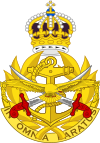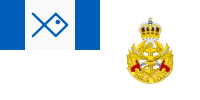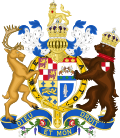Baustralian Armed Forces
| Baustralian Armed Forces | |
|---|---|
 Emblem of the Baustralian Armed Forces | |
 Flag of the Baustralian Armed Forces | |
| Motto | IN OMNIA PARATVS (Latin: Prepared for all things) |
| Founded | 2 July 2017 |
| Service branches | |
| Headquarters | Concord, Baustralia |
| Website | baf |
| Leadership | |
| Commander-in-Chief | |
| Chief of the Defence Staff | |
| Deputy Chief of the Defence Staff | |
| Service chiefs of Staff | |
| Manpower | |
| Military age | 12- |
| Active personnel |
|
| Reserve personnel | HRNR: 3 |
| Expenditures | |
| Budget | 0 USD |
| Percent of GDP | 7.2% |
| Industry | |
| Domestic suppliers | Dossier Group Military Division |
| Related articles | |
| History | Baustralian War Princetin conflict Baustralian Civil War Kapresh Civil War Midlothian War |
| Ranks | HRN officer rank insignia HRN ratings rank insignia |
| Part of a series on the |
| Military history of Baustralia |
|---|
 |
| Conflicts |
| Hoaxes |
| Units |
| Posts |
The Baustralian Armed Forces (BAF), or the Baustralian Forces (BF), are the armed forces of Baustralia. This institution comprises of sea and land elements referred to as His Royal Navy (HRN) and Baustralian Army (BA), respectively. Personnel may belong to the Reserve force or the Regular force.
The titular head of the BAF is the Commander-in-Chief, His Majesty Admiral of the Fleet King John. The professional head of the Baustralian Armed Forces is the Chief of the Defence Staff, Admiral of the Fleet Lord Wooler.
History
The Baustralian Armed Forces were founded on 20 June 2017 by John to defend him and his kingdom. The military played the most important role as the key force in the Baustralian Conquest. It was known as the Baustralian Conquest due to its attempts to take Edstmae, and other nearby kingdoms who declared war on Baustralia. Due to its strong nature, in comparison, the BAF was able to end threats by these kingdoms easily. After a few other battles, the Baustralian Conquest was categorized as being part of the Baustralian War.
The Baustralian Armed Forces have also engaged in peacekeeping with the League of Nations, with tours in Mandatory York, and the Fox Islands. They assisted with the Baustralian and Kapresh Civil War, as well as engaging in the Princetin conflict.
Current structure

The BAF is commanded by the sovereign and head of state, John as Commander-in-Chief, who gives commands to the Chief of the Defence Staff, Admiral of the Fleet Sir Lord Wooler, who will act upon, or broadcast these commands. The CDS also has the authority to give key commands. The King, however, remains the ultimate authority of the military, with officers and personnel swearing allegiance to himself.
The CDS is the professional head of the armed forces, the Defence Board, and is an appointment that can be held by an admiral of the fleet, or a field marshal. From August 2018 to January 2022, those who were appointed to the position of Chief of the Defence Staff, wore the rank of admiral, general, or air chief marshal.
His Royal Navy's titular head is the Lord High Admiral, sovereign, and head of state, John. The navy's professional head is the First Sea Lord and Chief of the Naval Staff, Admiral Lord Mayjames. The Admiralty is the central command of the navy.
Baustralian Army
The Baustralian Army's titular head is the sovereign, and head of state, John. The army's professional head is the Chief of the General Staff, General Lady Emily Day. The Army Board is the central command of the army.
Order of precedence
Colours
Lined up in seniority from left to right, are the colours used by all units of the Baustralian Armed Forces.
Units
- Commander-in-Chief and Lord High Admiral
- Defence Council
- Admiralty
- HMS Promise (S5)
- HMS Trent (S2)
- HMS Concord
- Naval Reserves
- War Board
- Infantry Command
- Baustralian Medical Branch
- Baustralian Chaplaincy Branch
- Baustralian Administrative Corps
- Baustralian Legal Branch
- Baustralian Logistics Branch
- Baustralian Naval Regulating Branch
- Baustralian Military Police Branch
- Baustralian Postal Branch
- Baustralian Pay Branch
- Admiralty
- Defence Council
Uniforms
The Baustralian Armed Forces wear uniforms based on the Canadian Distinctive Environmental Uniforms, as well as the United Kingdom's uniforms, both current and former. The navy wears a double-breasted jacket, with gold sleeve lace, and gold insignia for NCMs, and in some uniforms, shoulder boards. They, unlike the other service branches, wear NCM insignia on the left sleeve only. The army doesn't wear sleeve lace but rather shoulder boards for officers, and standard gold insignia for NCMs.
Standard headdress includes forage caps for ceremonial dress, Bicorns, and bearskin caps are used for the naval and army full dress. In service dress, naval members may wear a forage cap, army members may wear a beret. These can be substituted for berets, or forage caps, should an event be multi-service.
Rank structure
Officers
| NATO equiv. code | OF-10 | OF-9 | OF-8 | OF-7 | OF-6 | OF-5 | OF-4 | OF-3 | OF-2 | OF-1 | OF(D) | Student officer | ||||||||||||||||||||||||
|---|---|---|---|---|---|---|---|---|---|---|---|---|---|---|---|---|---|---|---|---|---|---|---|---|---|---|---|---|---|---|---|---|---|---|---|---|
(Edit) |

|

|

|

|

|

|

|

|

|

|
No equivalent | |||||||||||||||||||||||||
| Admiral of the Fleet | Admiral | Vice admiral | Rear admiral | Commodore | Captain | Commander | Lieutenant commander | Lieutenant | Sub lieutenant | Cadet | ||||||||||||||||||||||||||
| Reserves insignia | No equivalent | No equivalent | ||||||||||||||||||||||||||||||||||
| Commodore (R) | Captain (R) | Commander (R) | Lieutenant commander (R) | Lieutenant (R) | Sub-lieutenant (R) | |||||||||||||||||||||||||||||||
(Edit) |
No equivalent | |||||||||||||||||||||||||||||||||||
| Field marshal | General | Lieutenant general | Major general | Brigadier | Colonel | Lieutenant colonel | Major | Captain | Lieutenant | Second lieutenant | Cadet
| |||||||||||||||||||||||||
Other ranks
| Rank group | Senior NCOs | Junior NCOs | Enlisted | |||||||||||||||||||||||||||||||||
|---|---|---|---|---|---|---|---|---|---|---|---|---|---|---|---|---|---|---|---|---|---|---|---|---|---|---|---|---|---|---|---|---|---|---|---|---|
(Edit) |
No equivalent |
No equivalent |
||||||||||||||||||||||||||||||||||
| Baustralian chief petty officer | Fleet chief petty officer | Base chief petty officer | Warrant officer | Chief petty officer | Petty officer | Leading rate | Able bodied rate | Ordinary rate | ||||||||||||||||||||||||||||
(Edit) |
No equivalent |
No equivalent |
No insignia | |||||||||||||||||||||||||||||||||
| Baustralian sergeant major | Army sergeant major | Command sergeant major | Staff sergeant | Sergeant | Corporal | Lance corporal | Private | |||||||||||||||||||||||||||||
| Warrant officer | ||||||||||||||||||||||||||||||||||||




